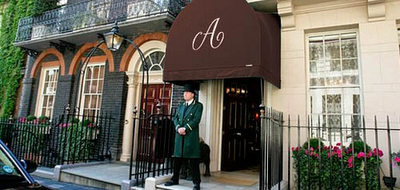John Aspinall
Added on July 1, 2025, in Gambling Legends by Gambling Gurus
John Aspinall, a Legend in GamblingJohn Aspinall | Gambling Legend
John Aspinall (11 June 1926 – 29 June 2000) was one of the most colorful characters in the heyday of British gambling during the Fifties and Sixties, who changed the face of the industry – some would say for the worse. So who was the man behind the smooth aristocratic facade, who charmed the rich and famous out of thousands of pounds on the tables of his Clermont Club?
A story of mystery and intrigue emerges, and questions that remain unanswered to this day, since Aspinall took his deepest secrets with him to the grave.
Early Life
John Victor Aspinall was not from aristocratic stock, although he would have dearly loved to have been so. Born to a middle class family he was to become a notorious social climber, managing to ingratiate himself with the upper classes through offering a service that the wealthy at that time were lacking: a decent gambling venue. John Aspinall had shown his passion for gambling early in life, when he feigned illness on the day of his finals at Oxford to go to see the Gold Cup at Ascot.
Such panache saw him well qualified for his chosen career as a British bookmaker!
Chemin de Fer
John Aspinall was not satisfied with this for long and soon decided to begin hosting gambling evenings for the aristocracy at upmarket venues in London. The only legal form of gambling in Great Britain at that time was Chemin de Fer (a variation of baccarat), or Chemmie as it was known. With venue hosts allowed to make a 5 per cent fee Aspinall decided to go for high rollers, and began hiring a series of houses in Mayfair and Belgravia to run events, since it was illegal to operate from the same premises for more than 3 events in a row.
The gambling nights attracted society figures such as Ian Fleming, Lucian Freud, Lord Lucan, the Earl of Derby, Lord Boothby and the Duke of Devonshire. The Queen’s racehorse trainer Bernard van Cutsem was another regular. London during the Fifties and Sixties was an exciting place to be, with the austerity of the war years fading and a new social circuit emerging, with gambling at its glamorous center. Aspinall sent out expensive, embossed invitations to Clermont evenings, and receiving one became a great honor.
A Good Night’s Work
The people invited to Aspinall’s tables were not the type in need of credit cards. The standard bet was today’s equivalent of roughly £25,000.
The games were quick, with one played every 30 seconds, with £50,000 exchanging hands per game. With his 5% cut Aspinall made the modern equivalent of a quarter of a million pounds on his first evening.
It was worth the risk of sailing close to the wind legally, and Aspinall’s mother was able to pay off local Metropolitan police officers.
Business continued briskly for several years, during which time John Aspinall bought Howletts Zoo, and fulfilled a lifetime’s ambition to own a large number of exotic animals. It became his passion and home until the end of his life.
Brushes With The Law
Eventually Aspinall’s luck ran out. His mother had forgotten to pay off the corrupt police officers and word of the gambling scam got out. The police raided the game, and arrested John Aspinall, who later won the case against him in what became known as Aspinall’s Law. It meant his operation could expand, and in the wake of charges he opened The Clermont Club in Berkley Square – named after another gambler, Lord Clermont.
It became a wild success. On one famous night Lord Derby, who owned vast tracts of land in Lancashire, lost £300,000 – the equivalent of nearly £7 million today. But the government had ensured that it was harder to profit from gambling, and the 5% profit games were no longer possible. Instead Aspinall had to pay tax and could only make a charge for the tables. With the added expense of the overheads on the property, profits were down.
The Great Swindle?
In pursuit of greater profits – his main aim – rumor has it now that Aspinall entered into a swindle scheme with a gangster friend called Billy Hill. The plan was simple but highly effective, according to the men involved in it, whom had recently spoken out about the scam. It involved putting money through a special ‘mangle’, which gave them an almost imperceptible curve. The cards were then repackaged and wrapped in cellophane, to be delivered to the club later in the evening.
By being able to judge whether a card was high, low or zero they could tip the odds in their favor. The scam, if it is true, proved highly effective and enabled John Aspinall to continue to live a charmed life, with his zoo animals well looked after for decades. Their upkeep was extremely costly, and Aspinall set up various clubs over the years to pay for the zoo. Today only Aspinall’s remains, in Curzon Street, Mayfair, which is run by his son Damien.
Lord Lucan
Mystery also surrounds Aspinall’s involvement in the disappearance of Lord Lucan, the infamous aristocrat who supposedly faked his own suicide after killing his children’s nanny by accident. He is believed to have fled to Africa with the help of ‘friends’, although he has never been found. Recently Aspinall’s ex-secretary reported conversations she had overheard about the incident, between John Aspinall and James Goldsmith.
She also maintains she was asked to arrange trips to Africa for Lucan’s children by John Aspinall, so that he could see them from a distance. In what would have been the biggest gamble of them all, Aspinall would have faced ruin and imprisonment should he have found out to be an accessory to Lucan’s disappearance. But he took the secret to the grave when he died in June 2000, in Westminster.






